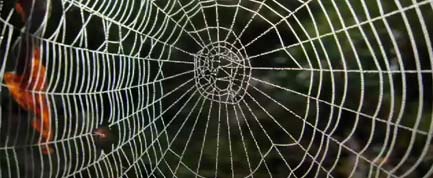Mysterious Step in Spider Silk-Making Revealed

Spider silk is stronger than steel and any available man-made fiber, and engineers have long puzzled over how to concoct a material with such strength and flexibility. They might be one step closer.
Researchers have just figured out one step in the silk-making process: how the liquid proteins the eight-legged creatures carry onboard get spun into webs at a moment's notice.
Specifically, spider silk has five times the tensile strength (a measure of how much something can be stretched before it breaks) of steel, and triple that of the best artificial fibers available today.
"The high elasticity and extreme tensile strength of natural spider silk are unmatched, even by fibers produced from pure spider silk proteins," said Horst Kessler, a professor at the Institute for Advanced Study at the Technische Universitaet Muenchen in Germany.
Kessler and colleagues wanted to pursue a particularly puzzling question: How do spiders keep the ingredients for silk at hand in such high concentrations, ready to be spun into webs at a moment's notice?
Spider silk is made of protein molecules that link together in long chains. In some areas, protein chains are interlinked through physical connections, which offer stability in those regions. In other areas, the protein chains remain unlinked, giving threads their high elasticity.
Before they become silk, the proteins are stored in a spider's silk gland, packed in tight in a liquid solution. The mystery is how the proteins are able to be stored in such a high concentration without the areas responsible for interlinking meeting up prematurely and clumping together before the spider is ready to build silk.
Sign up for the Live Science daily newsletter now
Get the world’s most fascinating discoveries delivered straight to your inbox.
To find out, the researchers used a technique called nuclear magnetic resonance spectroscopy. This technology allowed them to peer inside the silk gland of a European garden spider (Araneus diadematus) to study the elements that control how the proteins will bind together to form fibers.
"Under storage conditions in the silk gland these control domains are connected pair-wise in such a way that the interlinking areas of both chains cannot lie parallel to each other," said co-researcher Thomas Scheibel of the University of Bayreuth, also in Germany. "Interlinking is thus effectively prevented."
The protein chains are stored in a way so that, in the liquid solution, they will not link together. Once they enter the spider's spinning duct, where silk threads are made, the proteins encounter an environment with an entirely different salt concentration and composition. Here, the long protein chains are aligned in parallel, thus placing the areas responsible for interlinking side by side to form the stable silk fiber.
If scientists can understand these finer details of spider silk formation, they might eventually be able to build a man-made substance as strong. Such a thread would be invaluable for uses from surgical suture material to technical fibers for the automotive industry, the researchers said.
The results of the study will be detailed in the May 13 issue of the journal Nature.
- Video - Spider Silk as Strong as Kevlar!
- Gallery – Creepy Spiders
- Amazing Animal Abilities










